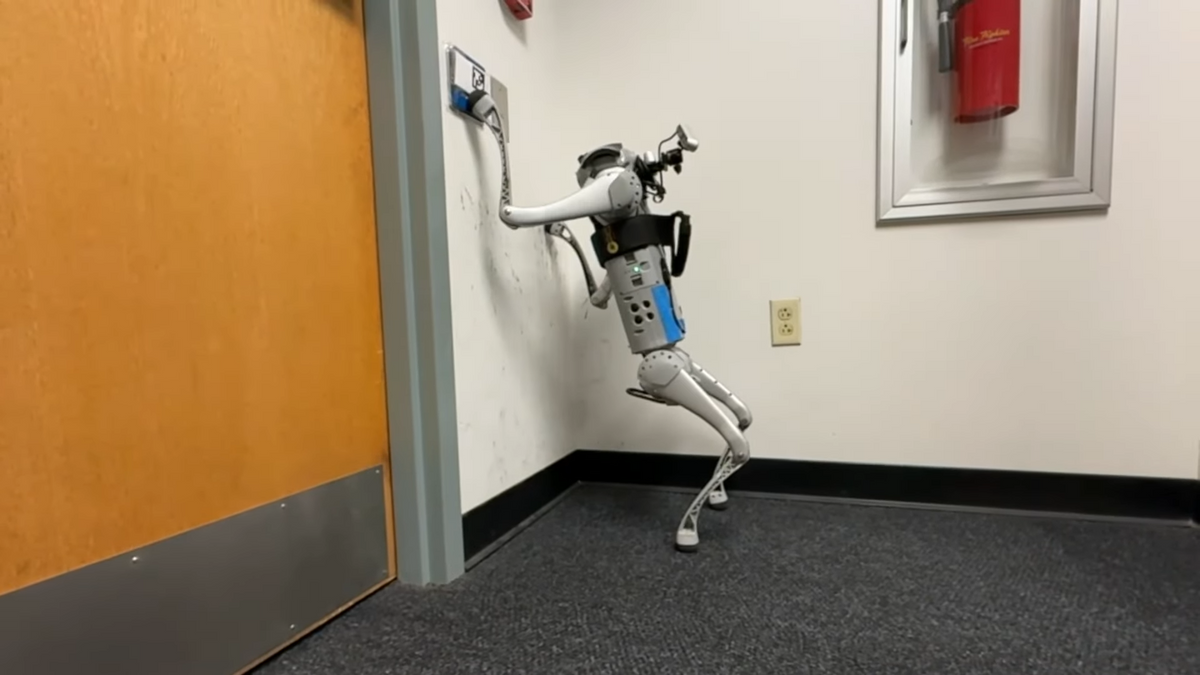We’ve gotten used to thinking of quadrupedal robots as robotic versions of dogs. And, to be fair, it’s right there in the word “quadrupedal.” But if we can just get past the Latin, there’s absolutely no reason why quadrupedal robots have to restrict themselves to using all four of their limbs as legs all of the time. And in fact, most other quadrupeds are versatile like this: four-legged animals frequently use their front limbs to interact with the world around them for nonlocomotion purposes.
Roboticists at Carnegie Mellon University and the University of California, Berkeley, are training robot dogs to use their legs for manipulation, not just locomotion, demonstrating skills that include climbing walls, pressing buttons, and even kicking a soccer ball.
Training a robot to do both locomotion and manipulation at the same time with the same limbs can be tricky using reinforcement-learning techniques, because you can get stuck in local minima while trying to optimize for skills that are very different and (I would guess) sometimes in opposition to each other. So, the researchers split the training into separate manipulation and locomotion policies, and trained each in simulation, although that meant an extra step smooshing those separate skills together in the real world to perform useful tasks.
Successfully performing a combined locomotion and manipulation task requires one high-quality expert demonstration. The robot remembers what commands the human gave during the demonstration, and then creates a behavior tree that it can follow that breaks up the tasks into a bunch of connected locomotion and manipulation subtasks that it can perform in order. This also adds robustness to the system, because if the robot fails any subtask, it can “rewind” its way back through the behavior tree until it gets back to a point of success, and then start over from there.
This particular robot (a Unitree Go1 with an Intel RealSense for perception) manages to balance itself against a wall to press a wheelchair access button that’s nearly a meter high, and then walk out the open door, which is pretty impressive. More broadly, this is a useful step toward helping nonhumanoid robots to operate in human-optimized environments, which might be more important than it seems. It’s certainly possible to modify our environments to be friendlier to robots, and we see this in places like hospitals (and some hotels) where robots are able to directly control elevators. This makes it much easier for the robots to get around, but it’s annoying enough to have to do that in some cases. It’s more practical (if not necessarily simpler) to just build a button-pushing robot instead. There’s perhaps an argument to be made that the best middle ground here is just to build broadly accessible infrastructure in the first place, by making sure that neither robots nor humans should have to rely on a specific manipulation technique to operate anything. But until we make that happen, skills like these will be critical for helpful legged robots.
Legs as Manipulator: Pushing Quadrupedal Agility Beyond Locomotion, by Xuxin Cheng, Ashish Kumar, and Deepak Pathak from Carnegie Mellon University and the University of California, Berkeley, will be presented next month at ICRA 2023 in London.
- Legged Robots Learn to Hike Harsh Terrain ›
- Quadruped Robots Can Climb Ladders Now ›
- Quadrupeds Are Learning to Dribble, Catch, and Balance - IEEE Spectrum ›
- Robot Videos: Robot Dog On a Ladder, Robot Birds, and More - IEEE Spectrum ›
- Tactile Controls: Why Buttons Are Making a Comeback - IEEE Spectrum ›
Evan Ackerman is a senior editor at IEEE Spectrum. Since 2007, he has written over 6,000 articles on robotics and technology. He has a degree in Martian geology and is excellent at playing bagpipes.



